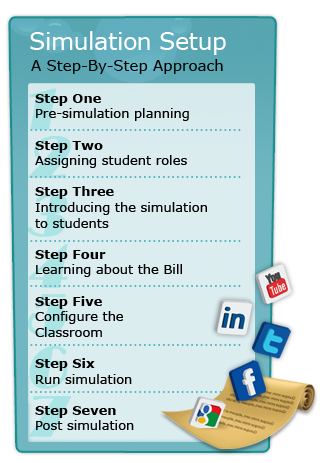
Explain to students that they are about to participate in a simulation that focuses on an important part of the process of the passage of legislation — committee stage. Ensure that students have a general understanding of the structure of Parliament and the passage of legislation by involving them in one or more of the following activities:
Read about committees: Discuss the role of parliamentary committees using the information found in Parliamentary Committees.
Watch parliamentary committees in action: Show students a video clip of a parliamentary committee at work. These clips are available on the ParlVU and Senate ParlVU websites. Elicit from students their view of the nature of the work depicted in the clip, as well as the role the committee is playing.
Extension: Discuss various terms related to the Canadian parliamentary system in sentences. Invite students to work with a partner to recall or infer the meaning of the terms. After attempting to explain the terms themselves, encourage students to consult the glossary to confirm their definitions. Discuss the key terms.
Explain that all students have important work to do in order to "get inside" their roles and to understand the issues. Organize students in pairs or groups based on their role in the simulation. Cut out the role cards. Distribute the appropriate role card to every student. Direct them to read about their role, and then turn to a fellow student and explain their role in their own words. Encourage students to ask any questions they might have.
Indicate to students that they will use their own names for the simulation, but remind them to speak and act from the perspective of the individual described in the role card. Political party names are not specified in this simulation, but you may choose to use made-up party names for the Government, Official Opposition and Other Opposition parties. Ask students to make a sign that will sit in front of them at their table during the simulation. The sign should include their name and title.
Distribute the following student handouts to each student, and allow them to work through the bill using the handouts provided to guide their preparation for the simulation. The work required of each student is dependent on their role in the simulation and is easily guided by the questions on the handouts. Where applicable, encourage students to work with other students who share a similar role. Circulate during this process, providing support to students in completing their preparation work.
| Role | Handouts—general | Modified |
| Minister and witnesses | Preparing your Role Presenting to the Committee Minister and Witness Material |
Preparing your Role Presenting to the Committee |
| Chair | Preparing your Role Chair Instructions |
Preparing your Role |
| Clerk | Preparing your Role Clerk Instructions |
Preparing your Role |
| Committee members | Preparing your Role Amendment proposal form |
Preparing your Role |
| Members of the press gallery | Preparing a Media report | Preparing a Media report |
